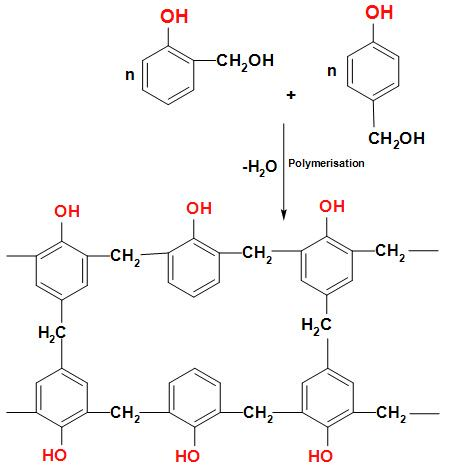
Bakelite is obtained from phenol by reacting with:
A.$C{H_3}COC{H_3}$
B.$HCHO$
C.${\left( {C{H_2}OH} \right)_2}$
D.$C{H_3}CHO$
Answer
557.7k+ views
Hint:
Bakelite which is a man-made polymer is an example of synthetic polymers. Polymers are the high molecular mass compounds obtained by joining or repeating structural units in a regular fashion. The simple reactive molecules from which the repeating structural units are derived are called monomers. The use of polymers in the manufacture of toys, synthetic clothing materials, packaging bags, automobile tyres, plastic buckets, cups and saucers etc. has completely revolutionised the daily as well as industrial scenario.
Complete answer:
-Phenol and Formaldehyde are the monomers of Bakelite.
-Phenol reacts with formaldehyde in presence of acid or dilute alkali as catalyst. A resinous polymer known as phenol-formaldehyde resin or bakelite results. In the reaction there is a formation of methylene bridges in ortho, para, or both ortho and para positions. As a result, either linear or cross-linked material is obtained. The reaction is difficult to control because condensation of ortho and para hydroxy methyl phenol leads to the formation of polymeric products. The final product is a dark, brittle and cross linked product, called Bakelite.


Cross-linked polymer bakelite
After discussing we can conclude that bakelite is obtained when phenol reacts with HCHO (formaldehyde).
Thus, the correct option is (B).
Note:Low degree of polymerization leads to the formation of soft bakelites which find use as binding glue for laminated wooden planks and in varnishes and lacquers. High degree of polymerization leads to the formation of hard bakelites which are used for making combs, phonograph records, electrical goods, fountain pen barrels, Formica table tops etc. Sulphonated bakelites are used as ion exchange resin for softening hard water. Cross linked bakelite is a thermo- setting bakelite.
Bakelite which is a man-made polymer is an example of synthetic polymers. Polymers are the high molecular mass compounds obtained by joining or repeating structural units in a regular fashion. The simple reactive molecules from which the repeating structural units are derived are called monomers. The use of polymers in the manufacture of toys, synthetic clothing materials, packaging bags, automobile tyres, plastic buckets, cups and saucers etc. has completely revolutionised the daily as well as industrial scenario.
Complete answer:
-Phenol and Formaldehyde are the monomers of Bakelite.
-Phenol reacts with formaldehyde in presence of acid or dilute alkali as catalyst. A resinous polymer known as phenol-formaldehyde resin or bakelite results. In the reaction there is a formation of methylene bridges in ortho, para, or both ortho and para positions. As a result, either linear or cross-linked material is obtained. The reaction is difficult to control because condensation of ortho and para hydroxy methyl phenol leads to the formation of polymeric products. The final product is a dark, brittle and cross linked product, called Bakelite.


Cross-linked polymer bakelite
After discussing we can conclude that bakelite is obtained when phenol reacts with HCHO (formaldehyde).
Thus, the correct option is (B).
Note:Low degree of polymerization leads to the formation of soft bakelites which find use as binding glue for laminated wooden planks and in varnishes and lacquers. High degree of polymerization leads to the formation of hard bakelites which are used for making combs, phonograph records, electrical goods, fountain pen barrels, Formica table tops etc. Sulphonated bakelites are used as ion exchange resin for softening hard water. Cross linked bakelite is a thermo- setting bakelite.
Recently Updated Pages
A man running at a speed 5 ms is viewed in the side class 12 physics CBSE

State and explain Hardy Weinbergs Principle class 12 biology CBSE

Which of the following statements is wrong a Amnion class 12 biology CBSE

Two Planoconcave lenses 1 and 2 of glass of refractive class 12 physics CBSE

The compound 2 methyl 2 butene on reaction with NaIO4 class 12 chemistry CBSE

Bacterial cell wall is made up of A Cellulose B Hemicellulose class 12 biology CBSE

Trending doubts
What are the major means of transport Explain each class 12 social science CBSE

Which are the Top 10 Largest Countries of the World?

Draw a labelled sketch of the human eye class 12 physics CBSE

Explain sex determination in humans with line diag class 12 biology CBSE

The pH of the pancreatic juice is A 64 B 86 C 120 D class 12 biology CBSE

Give 10 examples of unisexual and bisexual flowers




